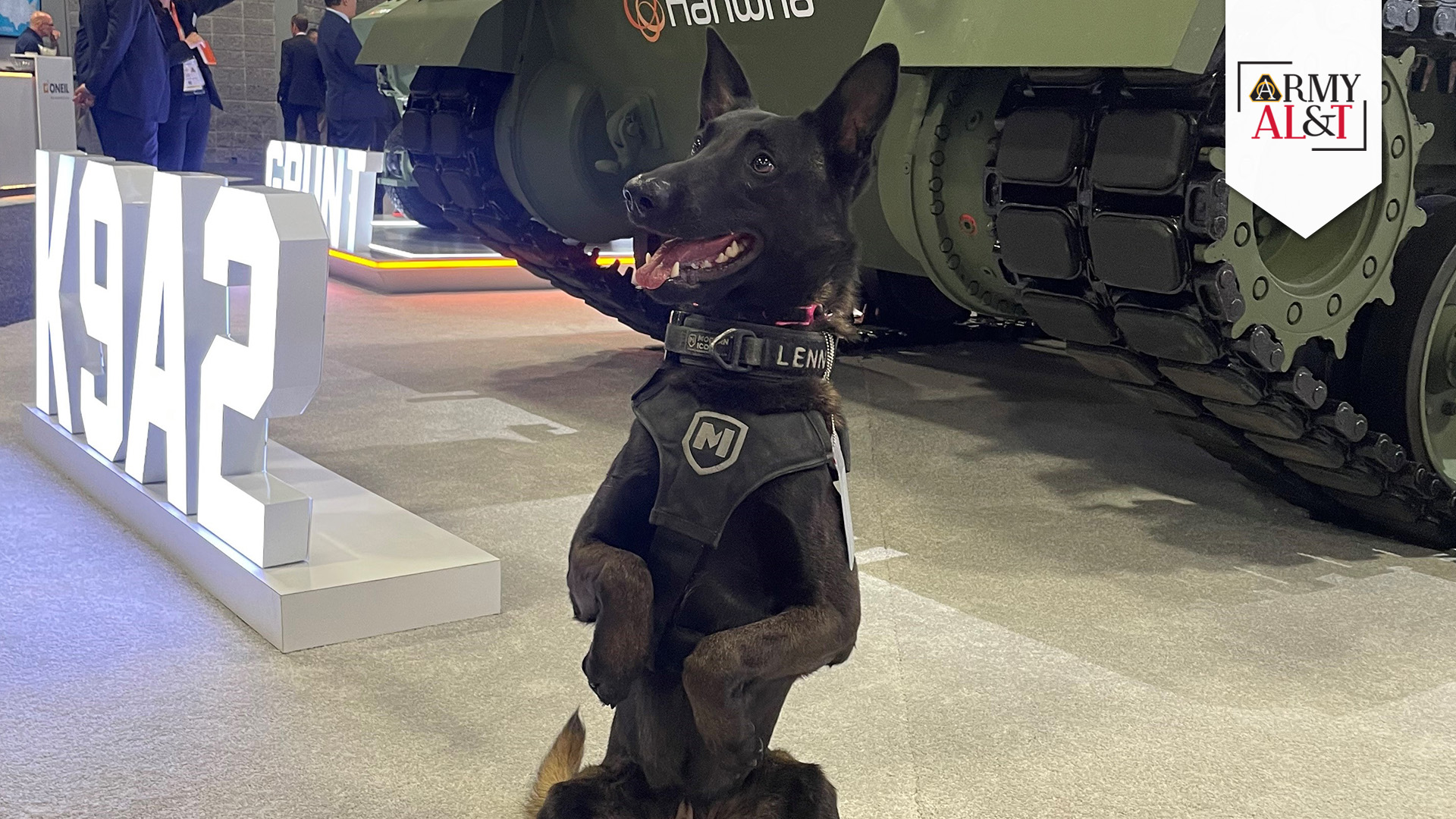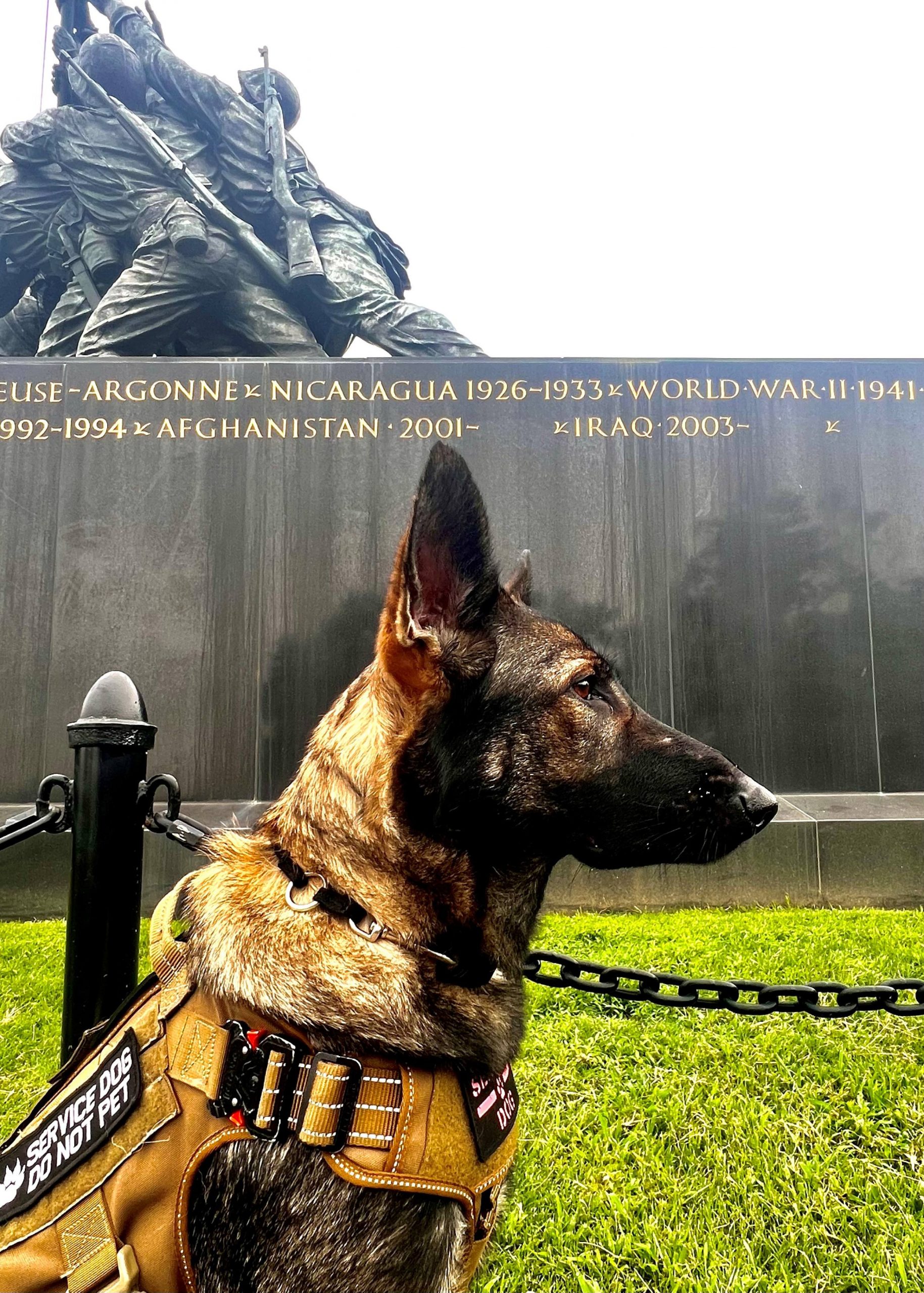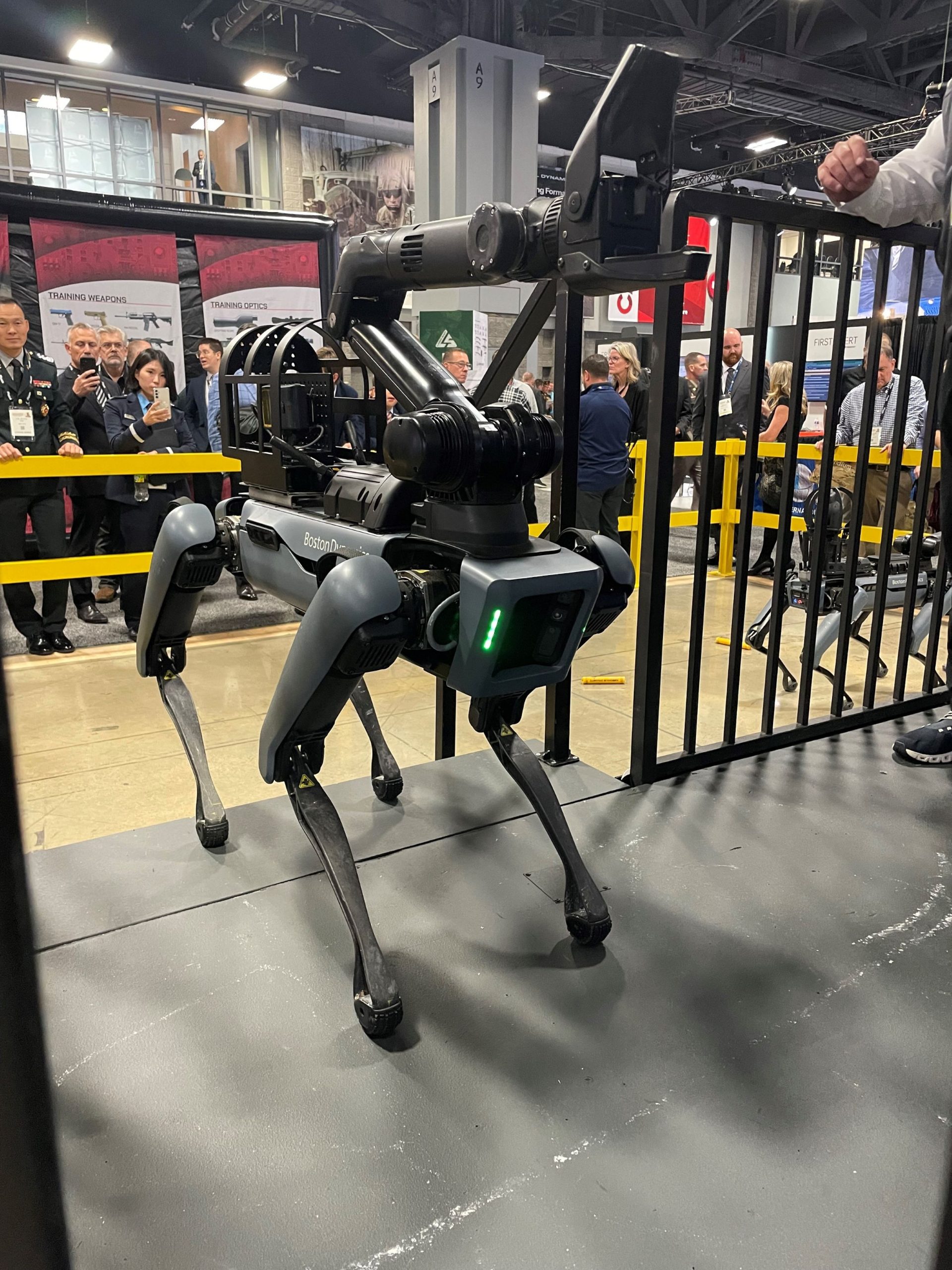
GOOD BOY
Lenny, a three-year-old Belgian Malinois explosive detection K9, poses for a picture at AUSA in October 2024. He is focused on his handler, Alisa Chmielinski, director of training and operations for 3DK9, who holds a toy reward for posing proficiency. (Photo by the author, USAASC)
Helping the military on four legs.
by Holly Comanse
Most people who own dogs will agree their pet has a positive impact on their mental and physical health. Dogs can help boost a person’s mood by being adorable and offering unconditional love or by encouraging their owners to get more exercise on long walks or playing fetch. While those benefits sound like something kids tell their parents when lobbying for a puppy, there are studies that link dog ownership to better heart health. In addition, there are many life-saving jobs for which dogs are relied on—for military and civilians alike.
Claymore, owned by retired Marine Corps Lt. Col. Ladd Shepard, is one of the many service dogs fulfilling that duty. The now two-year-old German shepherd was donated to Shepard when she was eight weeks old. “We picked her out [and] it saved my life,” said Shepard, who served in the Marines for almost 30 years and has been retired for four.
For fellow veterans considering a service dog, Shepard gave the following advice: “First, yes, do it! Second, there are a lot of great organizations out there that provide this service, many for free to veterans,” he explained, also cautioning that it may be a long process, though that is not always the case. “It starts with reaching out to make contact and explaining your circumstances,” he added. “Third and finally, it is one of the best investments in your health and wellbeing that you can make, but it is an investment.”
Shepard expressed the importance of understanding the extent of the work and time associated with any animal, including service animals prior to obtaining one. Making an informed decision is essential for any dog owner and there are many U.S. Department of Veterans Affairs resources available with more information to ensure the right animal ends up in the right home.
When encountering service animals in public, Shepard also advised: “When you approach a service animal team (dog and handler) it is generally okay to say something to the handler but best to ignore the service animal; even if the dog is breaking protocol and reaching out for affection, please don’t return it.” Service animals who are still in training may not be able to handle outside interaction or distractions as well as others who may have more experience in public. Just like humans, animals can also have bad or off days.
GET TO WORK
Not all dogs with jobs are the same. The Americans with Disabilities Act (ADA) defines a service animal as any breed or size of dog trained to perform a task directly related to a person’s disability. While many service animals wear vests and complete professional training, the ADA states that it is not a requirement. Emotional Support Animals (ESAs), or comfort dogs, are not service dogs, meaning they are not permitted in restaurants or places of business where service animals are accepted.
Service dogs help individuals on a personal level with a variety of mental and physical needs. On the other hand, working dogs, also referred to as canines (K9s), are human companions trained to perform tasks such as detection for police and the military to ensure the safety of people in various settings, such as concerts, airports or public events.
Military working dogs (MWDs) are K9s trained to support warfighters both on and off the battlefield, and they are an integral part of the Army’s mission, employing them in large-scale combat operations. With superior senses to humans, MWDs have been vital in successfully alerting warfighters of attacks, both physical and chemical. Among the most famous MWDs is the first dog to receive a rank, Sgt. Stubby, a stray dog that served in World War I. Today, there are about 1,600 MWDs in service helping to keep the nation safe. The 341st Training Squadron at Joint Base San Antonio is the sole provider of DOD MWDs. They run the MWD Program teaching service member handlers and all courses required for K9s to become MWDs. Training is tailored to the requirements of each branch of service, with additional training extended for special operations. The 341st Training Squadron also runs the Military Working Dog Adoption Program when dogs fail to meet MWD requirements or retire.

DO NOT PET
Claymore, a two-year-old German shepherd, awaits her next command at the Marine Corps War Memorial in Virginia. The loyal canine was donated to her handler, retired Lt. Col. Ladd Shepard and received training from Semper K9 Assistance Dogs. (Photo by Ladd Shepard, Headquarters Marine Corps)
Outside DOD, there are many veteran charity organizations and private organizations that train K9s for individual needs and public protection. Retired U.S. Army Cpl. Jeremiah Holder, the director of training at American K-9 Interdiction (AK9I), is no stranger to differing deployment experiences trained K9s face on mission and after retirement. “I have deployed to Mosul, Iraq, as patrol narcotic handler as a Soldier in the U.S. Army as well as worked for several contract companies at U.S. Embassy in Baghdad, Iraq, in which we transported our K9 with us personally to and from country each time,” Holder said. Occasionally, Holder will work his explosive detection K9 at public events like the Association of the United States Army (AUSA) Annual Meeting and Exposition. “Challenges honestly come with ensuring proper training is complete so that the dogs are able to work in hectic environments and getting the K9s neutral to all the stimulus happening around them,” Holder said.
For most dogs, working in a crowded space would be difficult, but for trained K9s, it’s another day at the office. “These animals serve a multitude of purposes. The No. 1 purpose they serve is saving lives,” said Alisa Chmielinski, director of training and operations for 3DK9 Detection Services. Her working dog, Lenny, also provided support throughout AUSA. “Whether it’s an explosive K9 or a narcotic K9, they are searching for something that is dangerous, something that has the ability to end lives, something that technology cannot detect and I believe that will never be able to detect as well as a dog.”
ROBOT DOGS
Although dogs have superior senses of smell and other innate abilities that can’t yet be replicated, technology continues to advance. The Army has started using quadruped (four-legged) robots in situations that would be too dangerous for dogs. The robot dogs can be controlled remotely or programmed to function automatically. A development priority was for the robot to be as terrain agnostic as possible, handling stairs and uneven ground with ease. The legs can operate independently, counterbalance and create resistance against threats. AUSA attendees had the opportunity to witness the robot dog named Spot in live demonstrations. Spot has been seen patrolling in Palm Beach, Florida, as part of the security measures put in place by the Secret Service to protect President Donald Trump.

WORKING LIKE A DOG
The four-legged robot from Boston Dynamics, named Spot, made an appearance at AUSA in October 2024 demonstrating its ability to navigate stairs, lift objects and open doors. (Photo by Holly Comanse, USAASC)
Approaching a threat can be dangerous for K9s and their handlers, but Spot can investigate and deescalate a potentially hazardous situation while the operator is at a safe distance. K9s can respond intuitively and immediately to a situation, but they also can get tired or distracted. Spot can be programmed to follow an automated schedule and monitor a perimeter for hours without ever taking a break. While a K9 is an active deterrent, Spot acts as a passive deterrent. There are benefits and risks to each and both are being utilized to their strengths.
CONCLUSION
There are many ways that dogs as pets, service animals, MWDs, K9s and ESAs improve the lives of civilians and military members. While each has its unique purpose, dogs remain a vital mission partner in service alongside our warfighters, both in and out of active-duty service, and the military wouldn’t be the same without them, four-legged robots included.
For more information about U.S. military working dogs, go to https://www.defense.gov/Multimedia/Experience/Four-Legged-Fighters.
HOLLY COMANSE provides contract support to the U.S. Army Acquisition Support Center from Honolulu, Hawaii, as a writer and editor for Army AL&T magazine and TMGL, LLC. She previously served as a content moderator and data specialist training artificial intelligence for a news app. She holds a B.A. in journalism from the University of Nevada, Reno.







